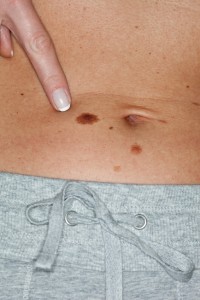The majority of cases of melanoma are treatable when diagnosed early. The seriousness of a particular melanoma relates to its thickness, so if the melanoma can be diagnosed when it is thin and less risky, simple surgical removal often yields an extremely high cure rate.

Atypical appearing mole
More than two decades ago, a general guideline was developed to help people recognize skin lesions that could be melanoma. The so-called “ABCD” guideline was a simple way of identifying key factors of moles or other lesions that required prompt attention to make sure that melanoma was not developing or already present. Ultimately, melanoma can only be diagnosed by skin biopsy, but whether through self skin exam, an annual skin exam by your physician, or if you have a lesion that is concerning, it is important to know whether the growth truly requires additional attention.
Hopefully, the ABCD paradigm, which some expand to include the E for “evolving”, and I expand to include the letter S, for suspicious, is well known. Here is a brief reminder but it should be remembered that this just represents an aid to recognition and should not replace any specific concerns that you have about particular skin lesions.
A–asymmetry. If you look at the lesion and fold it in half in your mind’s eye the two sides do not match. Normal moles typically grow in a somewhat circular and therefore symmetric fashion. Abnormal moles and melanoma, because of factors related to their biology of growth, may develop an asymmetric appearance. Continue Reading »
